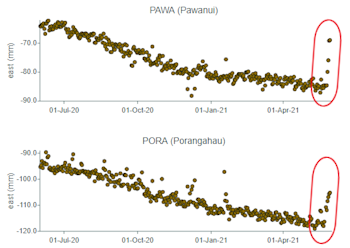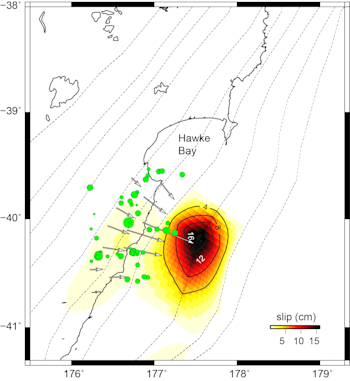
Slow-slip event off the coast of Pōrangahau
Scientists have been monitoring a slow slip event off the east coast near Pōrangahau that started in the last week of May.
This slow slip was anticipated to occur in this area this year, as the slow-slip record since 2002 shows an event every five years in the southern Hawke’s Bay region.
Data shows that GPS sites at Pōrangahau and Pawanui have moved about two centimetres eastward to date since the slow-slip event started.
Slow-slip events are quite common in this part of New Zealand, due to the subducting Pacific Plate moving westward under the Australian Plate. We’ve recorded dozens of these events since we first detected them in 2002 after adding GPS (Global Positioning System) instruments to the GeoNet and LINZ PositioNZ network around New Zealand to monitor land movement.
Slow-slip events (sometimes called silent earthquakes) are undetectable by both humans and our seismograph network because they move faults over weeks to months instead of within seconds like normal earthquakes. Monitoring and measuring these events is important because our scientists can use these land movements and changes offshore to better understand the processes at subduction zones and the relationship of slow slip events to earthquakes.
GNS scientists were able to start deploying instruments out across southern Hawke’s Bay and on the seafloor off Pōrangahau to capture the data (quakes and land displacement) before the event started.
Although humans can’t feel the slow-slip event itself, earthquakes associated with slow-slip events might be felt. A magnitude 4.2 earthquake near Waipukurau over the weekend is likely related to the slow-slip as it is similar to small earthquakes that tend to occur during these events.
What exactly is a slow-slip event?
Slow-slip events are like earthquakes, but instead of rupturing within seconds and minutes they can rupture over many weeks or even over years. They are undetectable to humans and our seismometers, and can only be picked up by monitoring the land movement by GPS which is why being able to deploy equipment at the beginning of an event is so important.
This GNS Science slow-slip animation helps explain what they are and why we study them.
Remember that these slow-slip events are quite common in New Zealand, and our scientists have been anticipating this. We will keep you posted on how the slow-slip event unfolds.
Subduction zones such as the boundary between the Australian and Pacific Plates are capable of producing large earthquakes – over magnitude 8. Although magnitude 8 earthquakes are rare, these slow-slip events can give scientists insight into the earthquake potential of the Hikurangi subduction zone.
Being prepared is important, so have an earthquake plan for you and your family.
In the event of a large earthquake: Drop, Cover and Hold. If you are near the coast and you feel a Long OR Strong earthquake, get to higher ground or as far inland as you can once the shaking has stopped in case a tsunami was generated. For more information on how to get prepared, visit the National Emergency Management Agency’s website getready.govt.nz.
Attributable to - Laura Wallace – GNS Science Geophysicist
Media enquiries - media@gns.cri.nz or 021 574 541




